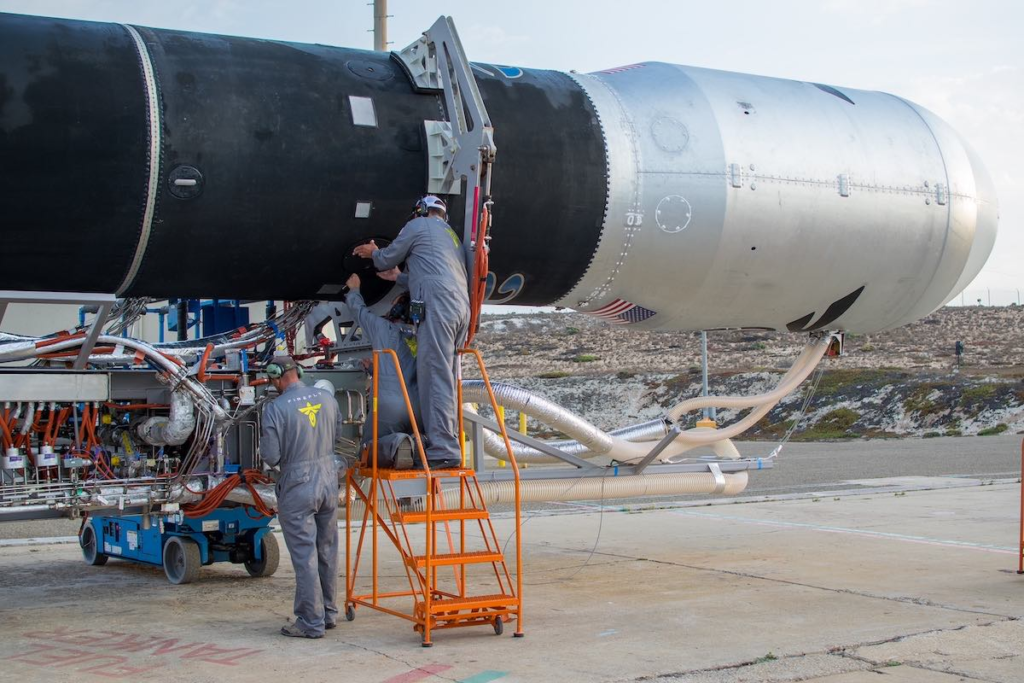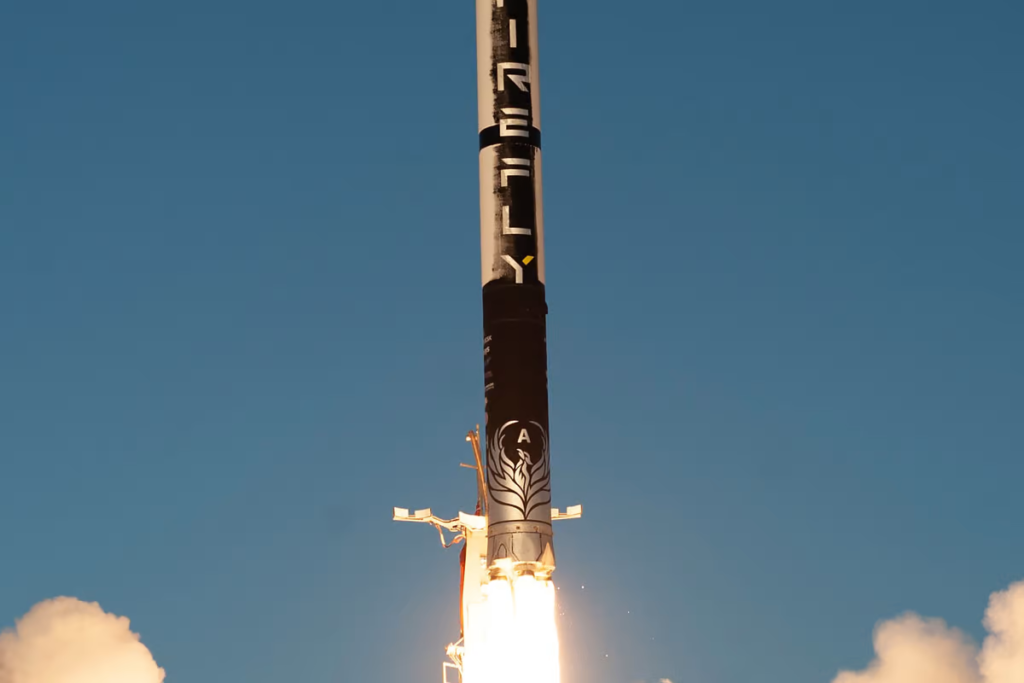
Firefly Aerospace Prepares For A Busy Launch Schedule
Not long ago Firefly Aerospace attempted their second ever orbital test flight and reported successful results. This was a massive milestone for the company and the start of consistent launch operations. Soon after the mission, Firefly made it clear that they would be attempting a total of 6 missions in 2023 and 12 in 2024. An extremely ambitious timeline from a company that only just reached orbit.
Recently they announced more testing in preparation for future launches in the coming months. The Alpha rocket is hoping to become a consistent and capable launch vehicle for small satellites and other payloads. All of which comes in addition to continued work on the company’s Blue Ghost lunar lander which is approaching its launch date as well.
Firefly’s small launch vehicle, Alpha, is hoping to provide more responsive, reliable, and affordable launch services for commercial, civil, and national security missions. However, scaling a rocket and performing multiple launches is much easier said than done. Here I will go more in-depth into recent Firefly and Alpha progress, the plan for this launch vehicle, what to expect in the coming months, and more.
Multiple Alpha Launches

Since the last orbital test flight, Firefly Aerospace has been busy preparing for an active year of missions. Just a few days ago on the 21st, the company tweeted saying, “Another beautiful Texas sunset highlights our Alpha rocket test stand as the team prepares multiple launches this year. Testing each launch vehicle before it flies is key to our mission success.” Back in October, Firefly announced that it’s Alpha FLTA002 mission successfully reached orbit and deployed customer payloads, lifting off on October 1 at 12:01am PST from Vandenberg Space Force Base in California.
They pointed out that with the success of this mission, Firefly became the first company to launch and reach orbit from US soil in only its second attempt. Firefly also becomes the first and only US commercial space company with a rocket ready to take customers to space in the highly desired 1300kg payload lift class. “With the success of this flight, Firefly has announced to the world there is a new orbital launch vehicle, available today, with a capacity that is pivotal to our commercial and government customers,” said Bill Weber, Firefly CEO. “Proving our flight and deployment capabilities on only our second attempt is a testament to the maturity of our technology and the expertise of our team. This is an exciting day at Firefly, and we have many, many more ahead. I could not be more excited for the Firefly team.”
Alpha is an all-composite rocket that uses patented tap-off engine cycle technology, which reduces cost and improves efficiency while maintaining the strength and reliability of the rocket. During the mission, Alpha successfully completed all major technical milestones, including a two-burn maneuver, relighting the second stage during its first orbital flight. “I am so proud of everyone in the company, both past and present, who have shared my dream of starting a launch company that would further revolutionize the space economy,” said Tom Markusic, Firefly Founder and Chief Technology Advisor. “The Firefly team set out to develop the best small launch vehicle in the world. Mission accomplished!”
As far as future missions, Firefly is completing the Acceptance Testing Protocol (ATP) for its Alpha 3 vehicle in preparation for its upcoming NASA VCLS Demo 2-FB ELaNa 43 launch. In addition, the company was quoted saying, “Firefly continues the production of multiple rockets at its Texas manufacturing facilities using all the lessons learned from existing flights and testing. Firefly is scheduled for six Alpha launches to take customer payloads to space in 2023, and 12 more in 2024.” Right now it looks like they are working toward that ambitious goal. In reality, 6 launches in 2023 is a hefty goal that will be quite hard for the company to do. However, it is possible as Firefly was working ahead even before the last test flight. In various videos from the company, you could see future Alpha launch vehicles in the background getting ready for future missions. No matter the outcome, it’s clear Firefly wants to become a busy launch provider with an impressive launch cadence. Something we can look forward to in the coming months.
Alpha Launch Vehicle

Now that we know more about Firefly’s last flight and its upcoming schedule, we can take a closer look at the vehicle itself and its unique design. Firefly’s small launch vehicle, Alpha, is meant to provide more responsive, reliable, and affordable launch services for commercial, civil, and national security missions. Using flight-proven rocket technologies, Alpha is 100% manufactured in America and is the only U.S. orbital rocket ready to take customers to space in its launch class. Alpha’s pump-fed, regeneratively-cooled engines use Firefly’s patented tap-off cycle that removes the need for excess engine components. This simple design allows us to reduce weight and launch more mass to orbit while maintaining the reliability of the rocket. Firefly also utilizes advanced carbon-fiber composites for Alpha’s entire airframe and cryogenic propellant tanks, enabling a strong, lightweight vehicle.
With dedicated launch facilities at the Vandenberg Space Force Base, Firefly is also expanding operations on the east coast at the Cape Canaveral Space Force Station to support more flexible launch options. For propulsion, Alpha utilizes well established technology. Both stages use common designs: copper regen-cooled LOx/RP-1 thrust chambers, a simple tap-off cycle which drives single shaft turbopumps, nozzle-mounted turbine exhaust manifolds, and hydraulic actuators. Innovations in Firefly engines include our simple “Crossfire” injector, tap-off geometry, dual-mounted electrically actuated, trimmable propellant main valves, and ultra-compact horizontal turbopump mounting. The upper stage engine, “Lightning,” includes a turbine-exhaust cooled refractory metal high area ratio nozzle extension. The first stage “Reaver” engines feature simple single axis gimballing. Consistent with the overall Alpha vehicle design, cost and performance are traded and optimized in Lightning and Reaver components to provide the best payload performance value.
In terms of the rocket’s structure, Firefly utilizes advanced carbon-fiber composites for the entire airframe of Alpha, including the state-of-the-art, linerless, cryogenic propellant tanks. They point out that composite materials are ideally suited to launch vehicle structures due to their high strength, low density and tailorable material properties. This allows Firefly Alpha to lift heavier payloads than a similar metal rocket.
Not only is the propulsion and structure important, but also the avionics. Firefly avionics hardware, such as the flight computer and communication system, utilizes a combination of custom designed and Commercial Off the Shelf (COTS) components with established flight heritage. Data Acquisition is accomplished using a modular Data Acquisition Chassis, which provides analog to digital conversion of all sensor data, and further packages the data and transmits it to the Flight Computer via an onboard Ethernet network. The Flight Computer incorporates all vehicle telemetry and transmits data along with video to various Earth ground stations along the flight trajectory, for the duration of the flight.
The Alpha payload fairing (PLF) is a carbon composite structure developed, manufactured, and qualified
by Firefly. It measures 2.2 m (7.2 ft) in diameter, and 5 m (16.4 ft) in height. The fairing separation system
employs a debris free, low-shock pneumatic separation system fully tested prior to each flight. All of which together create Firefly’s Alpha launch vehicle.
Focusing back on its future, late last year, Firefly announced that the company has been selected by The U.S. Space Force’s (USSF) Space Systems Command (SSC) to provide launch services for SSC’s VICTUS NOX mission. The effort was awarded as the Tactically Responsive Space (TacRS-3) Launch Service Task Order under the Orbital Services Program 4 (OSP-4) Contract. The VICTUS NOX mission will demonstrate an end-to-end Tactically Responsive Space capability, including the launch segment, space segment, ground segment, and on-orbit operations. VICTUS NOX will perform a Space Domain Awareness (SDA) mission from Low-Earth Orbit (LEO).
“We are honored to be chosen by Space Force for this important national security mission,” said Bill Weber, CEO of Firefly Aerospace. “Now more than ever, our country needs the ability for quick response capabilities to combat threats in space. Our Alpha launch vehicle is designed to drive affordable, rapid access to space. We look forward to working with Lt. Col. Justin Beltz and Lt. Col. MacKenzie Birchenough along with their experienced team at Space Force to help bring this innovation to the national security community.” The contract is worth $17.6M and is part of The U.S. Space Force’s mission to demonstrate end-to-end tactical responsive space capabilities. One of the multiple missions joining the growing list of Firefly’s future missions.
Conclusion
Firefly Aerospace is trying to increase launch cadence after its first successful mission. They have a large number of launches in place already and are trying to increase launch cadence. This includes a goal of 6 launches this year and 12 the next year. We will have to wait and see how it progresses and the impact it has on the space industry.
